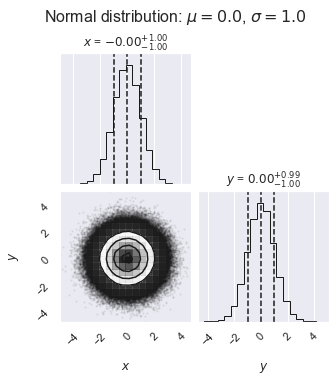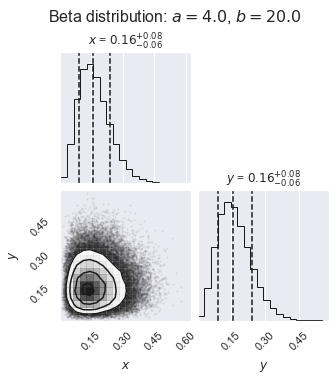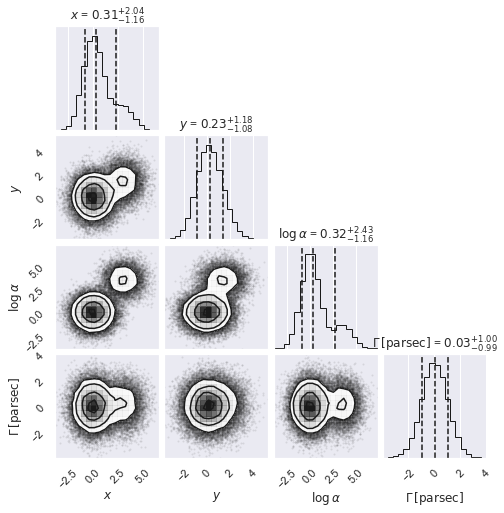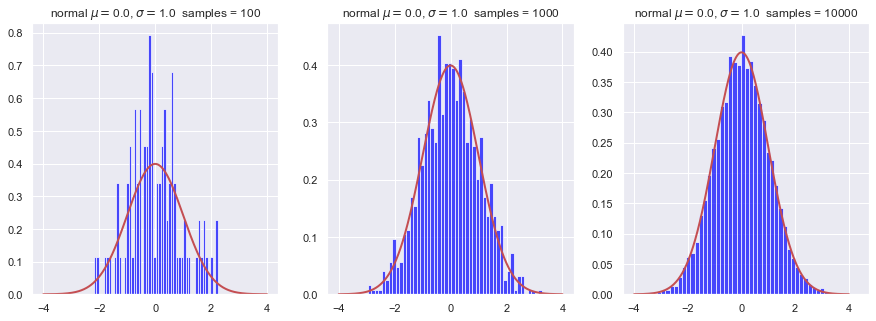1.2. Exploring PDFs¶
Goals: To play with plots of probability density functions (pdfs) using the scipy.stats and numpy libraries.
Work through the notebook but don’t just follow the instructions. Explore!
Answer the questions in italics. Check with your neighbors and ask for help if you get stuck or are unsure.
Quick overview: To a Bayesian, everything is a pdf (probability density function)¶
Physicists are used to dealing with pdfs as normalized wave functions squared. For a one-dimensional particle, the probability density at \(x\) is
$$ |\Psi(x)|^2 \Longrightarrow p(x) $$The probability of finding \(x\) in some interval \(a \leq x \leq b\) is found by integration:
$$ p(a \leq x \leq b) = \int_a^b |\Psi(x)|^2 \; dx $$Just as with “Lagrangian” vs. “Lagrangian density”, physicists are not always careful when saying probability vs. probability density.
Physicists are also used to multidimensional normalized pdfs as wave functions squared, e.g. probability density for particle 1 at \(x_1\) and particle 2 at \(x_2\):
$$ |\Psi(x_1, x_2)|^2 \Longrightarrow p(x_1,x_2) \equiv p(\textbf{x}) \quad \mbox{with}\quad \textbf{x} \equiv \{x_1,x_2\} $$(Note that you will find alternative notation in the physics and statistics literature for generic pdfs: \(p(\textbf{x}) = P(\textbf{x}) = \textrm{pr}(\textbf{x}) = \textrm{prob}(\textbf{x}) = \ldots\) )
Some other vocabulary and definitions:
\(p(x_1,x_2)\) is the joint probability density of \(x_1\) and \(x_2\).
What is the probability to find particle 1 at \(x_1\) and particle 2 anywhere? \(\color{blue}{\int\! |\Psi(x_1,x_2)|^2 dx_2}\) (integrated over the full domain of \(x_2\), e.g., 0 to \(\infty\)).
The marginal probability density of \(x_1\) is: \(\color{blue}{p(x_1) = \int\! p(x_1,x_2)\,dx_2}\).
“Marginalizing” = “integrating out” (eliminates from the posterior the “nuisance parameters” whose value you don’t care about).
In Bayesian statistics there are pdfs (or pmfs if discrete) for experimental and theoretical uncertainties, fit parameters, hyperparameters (what are those?), events (“Will it rain tomorrow?”), etc. Even if \(x\) has the definite value \(x_0\), we can use the pdf \(p(x) = \delta(x-x_0)\).
Questions?
# set up for plots in this notebook using matplotlib
# [Note: this is not generally necessary anymore.]
%matplotlib inline
import scipy.stats as stats # We'll use stats as our source of pdfs
import numpy as np
import matplotlib.pyplot as plt
import corner # for making "corner plots" showing 2-dimensional posteriors
import seaborn as sns; sns.set() # nicer plots!
Visualization of pdfs¶
Quick introduction to scipy.stats¶
If you google “scipy.stats”, you’ll likely get the manual page as the first hit: [https://docs.scipy.org/doc/scipy/reference/stats.html ]. Here you’ll find a long list of the continuous and discrete distributions that are available, followed (scroll way down) by many different methods (functions) to extract properties of a distribution (called “Summary Statistics”) and do many other statistical tasks.
Follow the link for any of the distributions (your choice!) to find its mathematical definition, some examples of how to use it, and a list of methods. Some methods of interest to us here:
mean() - Mean of the distribution.
median() - Median of the distribution.
pdf(x) - Value of the probability density function at x.
rvs(size=num_pts) - generate num_pts random values of the pdf.
interval(alpha) - Endpoints of the range that contains alpha percent of the distribution.
Try out some of the examples (cut-and-paste from the manual page after turning off the >>>s by clicking in the upper right of a box). We’ll use all of these methods in explicit examples below.
Matplotlib plotting definitions¶
We first define a few functions that we’ll use to extract and plot quantities of interest.
After you’ve looked at the examples that follow, come back and make sure you know what the functions are doing.
def dist_stuff(dist):
"""
Finds the median, mean, and 68%/95% credible intervals for the given
1-d distribution (which is an object from scipy.stats).
"""
# For x = median, mean: return x and the value of the pdf at x as a list
median = [dist.median(), dist.pdf(dist.median())]
mean = [dist.mean(), dist.pdf(dist.mean())]
# The left and right limits of the credibility interval are returned
cred68 = dist.interval(0.68)
cred95 = dist.interval(0.95)
return median, mean, cred68, cred95
def dist_mode(dist, x):
"""
Return the mode (maximum) of the 1-d distribution for array x.
"""
x_max_index = dist.pdf(x).argmax()
# Return x of the maximum and the value of the pdf at that x
mode = [x[x_max_index], dist.pdf(x[x_max_index])]
return mode
def dist_plot(ax, dist_label, x_dist, dist, color='blue'):
"""
Plot the distribution, indicating median, mean, mode
and 68%/95% probability intervals on the axis that is passed.
"""
median, mean, cred68, cred95 = dist_stuff(dist)
mode = dist_mode(dist, x_dist)
ax.plot(x_dist, dist.pdf(x_dist), label=dist_label, color=color)
ax.set_xlabel('x')
ax.set_ylabel('p(x)')
# Point to the median, mode, and mean with arrows (adjusting the spacing)
text_x = 0.2*(x_dist[-1] - x_dist[0])
text_x_mid = (x_dist[-1] + x_dist[0]) / 2.
text_y = mode[1]*1.15
ax.annotate('median', xy=median, xytext=(text_x_mid+text_x, text_y),
arrowprops=dict(facecolor='black', shrink=0.05))
ax.annotate('mode', xy=mode, xytext=(text_x_mid-text_x, text_y),
arrowprops=dict(facecolor='red', shrink=0.05))
ax.annotate('mean', xy=mean, xytext=(text_x_mid, text_y),
arrowprops=dict(facecolor='blue', shrink=0.05))
# Mark the credible intervals using shading (with appropriate alpha)
ax.fill_between(x_dist, 0, dist.pdf(x_dist),
where=((x_dist > cred68[0]) & (x_dist < cred68[1])),
facecolor='blue', alpha=0.2)
ax.fill_between(x_dist, 0, dist.pdf(x_dist),
where=((x_dist > cred95[0]) & (x_dist < cred95[1])),
facecolor='blue', alpha=0.1)
ax.legend();
Some standard pdfs: normal and beta distributions¶
# Make some standard plots: normal, beta
fig = plt.figure(figsize=(15,5))
# Standard normal distribution -- try changing the mean and std. dev.
x_norm = np.linspace(-4, 4, 500)
mu = 1 # mean
sigma = 2.0 # standard deviation
norm_dist = stats.norm(mu, sigma) # the normal distribution from scipy.stats
norm_label='normal pdf' + '\n' + rf'$\mu=${mu:1.1f}' \
+ '\n' + rf'$\sigma=${sigma:1.1f}'
ax1 = fig.add_subplot(1,3,1)
dist_plot(ax1, norm_label, x_norm, norm_dist)
# beta distribution, characterized by a and b parameters
x_beta = np.linspace(-0.1, 1.1, 500) # beta ranges from 0 to 1
a1 = 2
b1 = 1
beta_dist = stats.beta(a1, b1) # the beta distribution from scipy.stats
beta1_label='beta pdf' + '\n' + rf'$a=${a1:1.1f}' \
+ '\n' + rf'$b=${b1:1.1f}'
ax2 = fig.add_subplot(1,3,2)
dist_plot(ax2, beta1_label, x_beta, beta_dist)
# another beta distribution
#x_beta = np.linspace(-0.1, 1.1, 500)
a2 = 1
b2 = 1
beta2_dist = stats.beta(a2, b2)
beta2_label='beta pdf' + '\n' + rf'$a=${a2:1.1f}' \
+ '\n' + rf'$b=${b2:1.1f}'
ax3 = fig.add_subplot(1,3,3)
dist_plot(ax3, beta2_label, x_beta, beta2_dist)
mu2 = beta2_dist.mean()
sigma2 = beta2_dist.std()
norm2_dist = stats.norm(mu2, sigma2)
ax3.plot(x_beta, norm2_dist.pdf(x_beta), color='red')
fig.tight_layout()

The 68%/95% probability regions are shown in dark/light shading. When applied to Bayesian posteriors, these are known as credible intervals or DoBs (degree of belief intervals) or Bayesian confidence intervals. The horizontal extent on the \(x\)-axis translates into the vertical extent of the error bar or error band for \(x\).
The values of the mode, mean, median can be used as point estimates for the “probable” value of \(x\).
If you had a symmetric bimodal distribution, what point estimate would be best? Or are they all poor?
Things to try:
Change the normal (Gaussian) distribution so that it has a different mean and standard deviation.
Add another plot to one of the graphs. E.g., generate a normal distribution with the same mean and about the same width as the beta distribution with \(a=10\), \(b=10\) and add it to that plot. You don’t need to call a special function, just use
norm2_dist = stats.norm(mu2, sigma2)with your guesses for the \(\mu\) and \(\sigma\) values and thenax3.plot(x_beta, norm2_dist.pdf(x_beta), color='red')to overlay the curve onax3.Try some other distributions.
Another standard class of pdf: Student t¶
Find the functional definition on the web page. Is it consistent with the plots?
What are the loc and scale parameters?
# Make some plots of the Student t distribution
fig = plt.figure(figsize=(15,5))
x_t = np.linspace(-5, 5, 500)
norm1_dist = stats.norm(0.,1.) # a normal distribution for comparison
nu1 = 1.01
t1_dist = stats.t(nu1) # the Student t distribution
t1_label='t pdf' + '\n' + rf'$\nu=${nu1:1.1f}'
ax1 = fig.add_subplot(1,3,1)
dist_plot(ax1, t1_label, x_t, t1_dist)
ax1.plot(x_t, norm1_dist.pdf(x_t), color='red')
nu2 = 3
t2_dist = stats.t(nu2) # the Student t distribution
t2_label = 't pdf' + '\n' + rf'$\nu=${nu2:1.1f}'
ax2 = fig.add_subplot(1,3,2)
dist_plot(ax2, t2_label, x_t, t2_dist)
#ax2.plot(x_t, norm1_dist.pdf(x_t), color='red')
nu3 = 100
t3_dist = stats.t(nu3) # the Student t distribution
t3_label = 't pdf' + '\n' + rf'$\nu=${nu3:1.1f}'
ax3 = fig.add_subplot(1,3,3)
dist_plot(ax3, t3_label, x_t, t3_dist)
#ax3.plot(x_t, norm1_dist.pdf(x_t), color='red')
var2 = t2_dist.var()
print(f'variance for nu2: {var2}')
variance for nu2: 3.0

Note the “heavy tails” in the t distribution as \(\nu\) gets small. As \(\nu\) gets large, the distribution approaches a standard normal (Gaussian) distribution.
Try superposing a normal pdf on each. (The code is already there, just commented out, but make sure you understand what the statements are doing.)
What is the variance of each of the t distributions (use the var method)? Any surprises?
Projected posterior plots¶
Here we use the corner package to make some projected posterior plots. (Note: there are other choices to make these plots but corner is really fast.)
# examples of corner plots
ndim, nsamples = 2, 1000000
#np.random.seed(42)
# generate some synthetic data from a normal distribution
mu, sigma = 0., 1.
norm_samples = stats.norm.rvs(size=ndim * nsamples, loc=mu, scale=sigma).reshape([nsamples, ndim])
figure1 = corner.corner(norm_samples,
labels=[r"$x$", r"$y$", r"$\log \alpha$"],
quantiles=[0.16, 0.5, 0.84],
show_titles=True, title_kwargs={"fontsize": 12})
ax = figure1.get_axes()
my_suptitle = rf'Normal distribution: $\mu = {mu:.1f}$, ' + \
rf'$\sigma = {sigma:.1f}$'
figure1.suptitle(my_suptitle, y=1.0, va='bottom', fontsize=16)
figure1.set_size_inches(5,5)
ndim, nsamples = 2, 100000
#np.random.seed(42)
# generate some synthetic data from a beta distribution
a = 4
b = 20
beta_samples = stats.beta(a,b).rvs(size=ndim * nsamples) \
.reshape([nsamples, ndim])
figure2 = corner.corner(beta_samples,
labels=[r"$x$", r"$y$", r"$\log \alpha$"],
quantiles=[0.16, 0.5, 0.84],
show_titles=True, title_kwargs={"fontsize": 12})
my_suptitle = rf'Beta distribution: $a = {a:.1f}$, $b = {b:.1f}$'
figure2.suptitle(my_suptitle, y=1.0, va='bottom', fontsize=16)
figure2.set_size_inches(5,5)


What do you learn from these plots?
Try replotting several times with only 1000 samples each and note how much the plots change.
# now more than one mode (all random)
ndim, nsamples = 4, 50000
np.random.seed(1234)
data1 = np.random.randn(ndim * 4 * nsamples // 5) \
.reshape([4 * nsamples // 5, ndim])
mean = 4*np.random.rand(ndim)
data2 = (mean[None, :] + np.random.randn(ndim * nsamples // 5) \
.reshape([nsamples // 5, ndim]))
samples = np.vstack([data1, data2])
#figure = corner.corner(samples)
figure = corner.corner(samples, labels=[r"$x$", r"$y$", r"$\log \alpha$", \
r"$\Gamma \, [\mathrm{parsec}]$"],
quantiles=[0.16, 0.5, 0.84],
show_titles=True, title_kwargs={"fontsize": 12})
figure.set_size_inches(7,7)

What do you learn from these plots?
Sampling of 1d pdfs in Python¶
Here we show how histogrammed samples become closer to the continuous pdf as the sample size increases.
def plot_hist(ax, name, x_dist, dist, num_samples, num_bins):
"""Plot a pdf and a histogram of samples"""
samples = dist.rvs(size=num_samples) # draw random samples from the pdf
# Make a histogram of the random samples
count, bins, ignored = ax.hist(samples, num_bins, density=True,
color='blue', alpha=0.7)
ax.plot(x_dist, dist.pdf(x_dist), linewidth=2, color='r') # true pdf
title_string = name + f' samples = {num_samples:d}'
ax.set_title(title_string)
mu, sigma = 0, 1.0 # mean and standard deviation
x_dist = np.linspace(-4, 4, 500)
name = rf'normal $\mu=${mu:1.1f}, $\sigma=${sigma:1.1f}'
fig = plt.figure(figsize=(15,5))
num_bins = 50
num_samples = 100
norm_dist = stats.norm(mu, sigma)
ax_1 = fig.add_subplot(1, 3, 1)
plot_hist(ax_1, name, x_dist, norm_dist, num_samples, num_bins)
num_samples = 1000
norm_dist = stats.norm(mu, sigma)
ax_2 = fig.add_subplot(1, 3, 2)
plot_hist(ax_2, name, x_dist, norm_dist, num_samples, num_bins)
num_samples = 10000
norm_dist = stats.norm(mu, sigma)
ax_3 = fig.add_subplot(1, 3, 3)
plot_hist(ax_3, name, x_dist, norm_dist, num_samples, num_bins)

To do:
Find the mean of the random samples and compare to \(\mu=0\) for each sample size. (You might add a statement to the plot_hist function to print the mean, using that samples.mean() (don’t forget the ()’s) gives the mean of the distribution samples.) Conclusion?